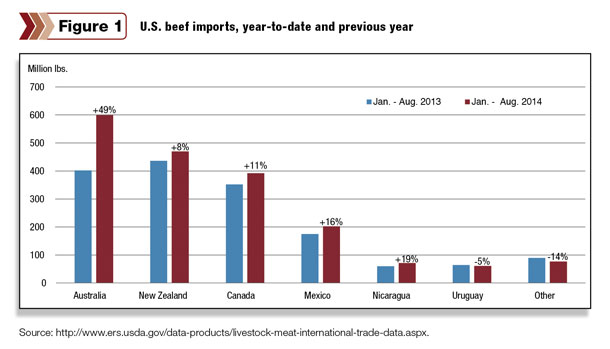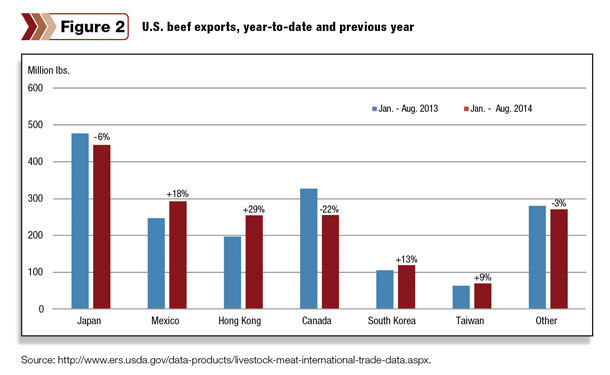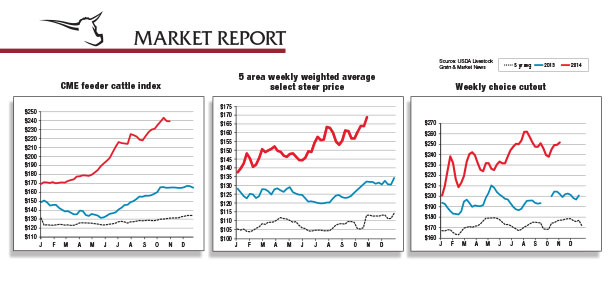Longer feeding periods are attractive to cattle feeders for several reasons related to lower costs and increased marketing options.
Hay supplies are also looking ample for winter feeding needs, improving prospects for retaining both breeding cows and replacement heifers through the winter.
Despite lower and declining corn prices, feeder cattle prices that are in the $220-plus-per-hundredweight (cwt) range, and generally increasing, are pushing future breakeven costs for Southern Plains fed cattle toward the $170-per-cwt level (High Plains Cattle Feeding Simulator: USDA - livestock & meat domestic data).
Weather conditions for most of cattle country have been favorable, with improving pasture conditions increasing the potential for the expansion of cow-calf production.
Declining cow slaughter may be the first sign of herd expansion, although expansion may not be very pronounced in 2014. The next few years will likely be characterized by an upward tick as cow numbers are rebuilt.
Click here or on the image about to view it at full size in a new window. (PDF, 26.8KB)
Further, dressed weights have increased dramatically year over year, largely due to both increased feeding periods and an increased proportion of steers in the slaughter mix.
The increased feeding periods are, in part, a result of lower corn prices, which make it feasible for cattle feeders to feed cattle longer, extending the ability of cattle feeders to hold out for higher prices against packers’ lower bids.
The increasing proportion of steers in the slaughter mix is a result of both declining cow slaughter and declining placements of heifers in feedlots as producers move toward rebuilding the aggregate cow inventory. Further, the proportion of steers in the slaughter mix is increasing despite declines in year-over-year steer slaughter.
While retail beef prices continue to set new record highs, meatpackers are experiencing seasonally negative margins. Current retail beef prices are providing some support for the relatively lower pork and poultry prices.
At the same time, pork and poultry supplies are abundant enough to exert downward pressure on pork and poultry prices, partially offsetting the upward pressure from higher beef prices. Further, the higher beef prices appear to be dampening consumer enthusiasm for beef and retailer enthusiasm for providing beef specials.
Cattle imports up 13 percent through August
U.S. cattle imports have increased from both Canada and Mexico this year, totaling 1.413 million head through August. Imports are up 14 percent from Mexico and 12 percent from Canada due to stronger demand for feeder cattle. The average price for Nebraska feeder steers ($7 to $8 cwt) was $205.57 during the first three quarters of 2014, compared with $149.45 during the first three quarters of 2013.
Diminished domestic cattle supplies have led to price growth and a 35 percent increase in feeder cattle imports from Canada and a 14 percent increase from Mexico.
Imports of feeder cattle follow a strong seasonal pattern, rising during the fall and spring due to diminished grazing conditions. Imports this summer, typically the slowest season, were well above last year’s levels, and AMS weekly data through the end of September also show stronger shipments than in 2013.
The forecast for U.S. cattle imports was raised to 2.2 million head in 2014 and 2.225 million head in 2015. Despite lower cattle inventories in both Canada and Mexico, strong prices for U.S. cattle are expected to pull cattle across the border.
Beef imports continue a strong run
U.S. beef imports totaled 1.873 billion pounds through August 2014, up 19 percent from a year earlier. Imports have risen nearly 50 percent from Australia, accounting for about two-thirds of the increase in import volume this year. Imports have also risen from New Zealand,

Canada and Mexico (see figure 1) due to lower domestic supplies of lean beef. Weekly federally inspected cow and bull slaughter was down 13 percent through Sept. 27, 2014, from the same period last year.
In contrast, Australian beef production was up 10 percent through August as drought conditions continue in Australia’s cattle-producing regions. Slaughter in Australia has continued at a record pace this year due to poor pasture conditions.
The surge in beef production has led to a 17 percent increase in Australian exports, with most of the increase going to the U.S. U.S. imports have also been stronger from Canada as high U.S. prices and a favorable exchange rate increase returns for Canadian sellers.
The forecast for U.S. beef imports in 2014 is 2.684 billion pounds, 19 percent higher than in 2013. Import demand is expected to remain strong in 2015 and is forecast to increase fractionally to 2.7 billion pounds.
Despite lower production in many countries that supply the U.S., high U.S. beef prices, coupled with expectations of a stronger U.S. dollar, support higher imports.

U.S. beef exports are up 1 percent this year through August as growth in trade to Mexico and a number of Asian markets have offset smaller shipments to Canada and Japan (see figure 2). After a strong start to the year, exports weakened during the third quarter.
The forecast for U.S. beef exports in 2014 was lowered 20 million pounds to 2.6 billion pounds, nearly unchanged from last year. Lower beef production and robust domestic demand have caused prices to strengthen over the past year.
The average value of boxed beef was 20 percent higher than the same period last year through July 2014. Despite higher prices, exports remain strong to many major U.S. markets.
Shipments rose by the greatest volume to Hong Kong (+58 million pounds), followed by Mexico (+45.5 million pounds) and South Korea (+38.4 million pounds). Japan remains the top market for U.S. beef despite a 6 percent decline in volume. Japanese imports of beef from all countries are down 6 percent this year, as sluggish economic conditions and a sales tax increase have weakened demand.
Canada has been another weak market for the U.S., with both higher prices and a weaker Canadian dollar dampening demand. Total exports are forecast to fall 3 percent next year to 2.525 billion pounds. While demand is expected to hold in several key U.S. markets, lower U.S. production and high prices will limit growth in U.S. exports. ![]()
Kenneth Mathews is coordinating analyst for the USDA Economic Research Service. Analysts Sahar Angadjivand and Lindsay Kuberka assisted with this report.







